

 Reference Site Map |
|
|
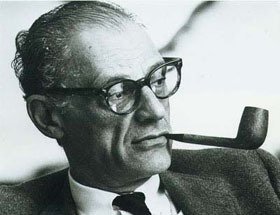 |
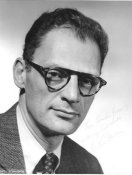 |
 |
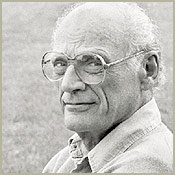 |
 |
American playwright Miller dies from BBC News. Playwright Arthur Miller, the creator of The Crucible and Death of a Salesman, has died at the age of 89, on 10 Feb. 2005, includes video.
See also Arthur Miller dead at 89 from CNN.com.
Arthur Miller: death of a playwright by Reporter: Anthony Mason.
Playwright Arthur Miller dies at age 89 from MSNBC, includes slide show.
An American Classic: Arthur Miller, Enduring Playwright - Online NewsHour: Arthur Miller Discusses His Life and Work with Paul Solman, Feb. 10, 1999. Listen to segment in RealAudio, 11 min. 36 sec. with transcript.
Playbill News: Renowned Playwright Arthur Miller, Author of Death of a Salesman, Is Dead at 89 by Kenneth Jones, Robert Simonson, and Ernio Hernandez.
Arthur Miller - Biography from Wikipedia, the free encyclopedia. Arthur Asher Miller, October 17, 1915 - February 10, 2005. See also Arthur Miller (1915-2005), Arthur Miller Timeline, American Masters: Arthur Miller from PBS, Arthur Miller Trivia.
Arthur Miller Files. Website created by seven University of Michigan students taking English 414 with Professor Eric Rabkin as a scholarly analysis of Arthur Miller and his works. Site includes: Timeline, The Crucible - Summary, Analysis, Production History, Biography of Arthur Miller, and more.
Arthur Miller Society. An incorporated, non-profit society whose primary aim is to promote the study of Arthur Miller and his work. Includes: A Brief Chronology of Arthur Miller's Life and Works, 1915-2005.
Arthur Miller: The Accidental Music Collector from BBC - Radio 4. "He had never been to the South before and was shocked by the racism and anti-semitism. He was held at gunpoint for being Jewish. Once he made his host, a health care organiser, incandescent with rage by addressing a black man as 'sir' rather than 'boy' (the man was in his fifties, Miller in his early twenties)."
Arthur Miller's THE CRUCIBLE: A Guide for Teachers - Written and Compiled by Jere Pfister, Edited by Eleanor Colvin, © Alley Theatre, 2005. Contents include: The Life of Arthur Miller, Miller's Production History at the Alley Theatre (The Crucible in 1959, 1994 and 2005), Playwright's Perspective, The 1950s, McCarthyism, The 21st Century, Three major surprises of the new millennium, Where has our fear led us?
CurtainUp: An Overview of Arthur Miller's Career by Elyse Sommer. Topics include: Personal Statistics, Play Chronology, Trademarks of Miller's Plays, The Crucible, a CurtainUp Review.
The American Colonist's Library: A Treasury of Primary Documents. Primary Source Documents Pertaining to Early American History, from Free Public.com.
Archiving Early America. Exploring the World of Early America through the Media of the Day (newspapers, maps, magazines and writings). Read a page from the 18th century newspaper: The Massachusetts Centinel published on Saturday, April 24, 1790. See Map of 13 Original Colonies. Read the obituaries of famous people from early America. Learn How To Read a 200 Year Old Document, plus many other interesting pages from the Colonial past, e.g. Firsts!! Lives of Famous Early Americans, Gallery of Early American Portraits, Short Films, Notable Women, etc.
Classics of American Colonial History from Dinsmore Documentation. Browse by author or subject.
Colonial America 1600-1775. Great K-12 Resources. Links under History - Colonial Life in America, Colonial North America, An Outline of American History - The Colonial Period, etc. Under State History - The Colonies One by One with information on each of the 13 colonies (Massachusetts was one of the original 13 colonies), Under Military History - Colonial Era Photos. Includes also links to Maps, Cooking, Everyday Life in the Colonies, Plantations & Other Historic Buildings, American Literature, Holidays, Music, Dance, and Art. Timeline: Colonial America 1600-1775.
A Colonial Family and Community. Be a history detective. Go back in time and investigate the daily lives of a real colonial family from Coventry, Connecticut. Collect clues to uncover answers to 7 questions about colonial life in the 1700s. A fun game with movies, sound, and music. Find what's wrong with two pictures.
Colonial history of the United States from Wikipedia, the free encyclopedia.
The Colonial Period. Contents: New Peoples, New England, The Middle Colonies, The Southern Colonies, Society, Schools and Culture, Emergence of Colonial Government, The French and Indian War, and The Witches of Salem.
Daily Life in the Colonies. What would it have been like to live during colonial times? See descriptions of daily life in the Colonies by clicking on different parts of a farm scene.
United States -- History -- Colonial period, ca. 1600-1775. Links to related resources from Librarians' Internet Index (LII).
Welcome to Colonial Williamsburg. "That the future may learn from the past."The History Explorer includes: Meet the People, See the Places, Colonial Dateline, Experience Colonial Life, and links to additional resources. Teacher Resources include Lesson Plans, Electronic Field Trips, A Day in the Life Video Series, and others.
| The Crucible (Penguin Classics)  |
The Crucible (Cliffs Notes)  |
The Crucible (Penguin Plays)  |
The Crucible (1996 Movie) (DVD)  |
Arthur Miller's The Crucible (Bloom's Guides) (Library Binding) ed. by Harold Bloom 
|
| Understanding The Crucible: A Student Casebook to Issues, Sources, and Historical Documents (The Greenwood Press "Literature in Context" Series) 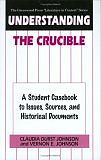 |
17th Century Colonial New England with Special Emphasis on the Essex County Witch-Hunt of 1692. Site provides valuable links to other resource material on The Crucible, including: Arthur Miller's The Crucible: Fact & Fiction (or Picky, Picky, Picky...) by Margo Burns, Hysteria and Ideology in The Crucible, and others.
Arthur Miller's THE CRUCIBLE: A Guide for Teachers - Written and Compiled by Jere Pfister, Edited by Eleanor Colvin, © Alley Theatre, 2005. Contents include: Miller's Production History at the Alley Theatre (The Crucible in 1959, 1994 and 2005), Playwright's Perspective, Synopsis of The Crucible, List of Characters, Major Themes in The Crucible, Historical Perspectives (The Puritans, Did witchcraft trials really occur in America? Why did the hangings in Salem stop? The 1950s, McCarthyism, The 21st Century, Discussion Questions & Activities (Women's Issues, Separation of Church and State, Settings of the Play), Symbolism in The Crucible, and more.
ClassZone: Language Arts: Novel Guides: The Crucible by Arthur Miller. Theme: When Fear Drives Mass Hysteria. Grades 10-11. Summary: "The Crucible, a historical drama, reflects examples of how a dogmatic society's mistrust of nonconformity can result in injustice. As witchcraft accusations fly in Puritan New England, John Proctor must choose between his own personal safety and the truth." Includes: Theme Openers, Crosscurricular Activities, and Research Assignments.
The Crucible - Movie Review by Diane Selkirk - Apollo Guide. Apollo Score: 78/100. "The Salem witch trials of 1692 are an infamous event in US history. The Crucible ... takes us back to this time with a dramatisation of the social conditions that led to the hanging of 19 people ..."
The Crucible - Movie Review by Jessica Z., Westwood, MA. "The movie realistically portrays many extreme emotions ..."
The Crucible (1996). Reviews of the 1996 film produced by 20th Century Fox. Links to reviews published in Detroit News, San Francisco Examiner, Box Office Magazine, Movieline, Houston Chronicle, and numerous other newspapers and magazines.
The Crucible from Moviefone. About this 1996 movie, released on DVD in 2004. Directed by Nicholas Hytner. Starring: Daniel Day-Lewis, Winona Ryder, Paul Scofield, Joan Allen, and others. Synopsis, Credits: Featured Cast and Crew, Movie Reviews.
The Crucible (1996) MovieSynopsis from MovieWeb. "A timeless tale of truth on trial, THE CRUCIBLE is a relentlessly suspenseful drama of collective evil and personal conscience. And at its center is a vastly moving story of guilt, love and redemption." The Crucible (1996). Film info on Arthur Miller's timeless tale of truth on trial. Release Date: November 27, 1996. Director: Nicholas Hytner. Writer: Arthur Miller. Cast: Starring Daniel Day-Lewis, Winona Ryder, and others.
The Crucible by Arthur Miller (1952).
The Crucible by Arthur Miller. Drama. Tragedy. Contemporary. Another article from Summary Central. 16 descriptive paragraphs to help refresh your memory of the play in greater detail. Contents: The Author and His Times, Point of View, Form Structure and Plot, Character, Setting, Themes, Style, Diction, Syntax, Imagery, Symbolism, Figurative Language, Ironic Devices, Tone, Memorable Quotes, and Additional Comments.
The Crucible from Wikipedia, the free encyclopedia. Plot Summary, Acts 1-4, Characters, Sub Characters, Historical Accuracy, Film Adaptions.
Crucible Essay Topics. Over 40 suggested essay topics on The Crucible from Good Essay Topics.
Miscellaneous Websites on The Crucible:
Jen's Crucible Web Page
Study Guides on The Crucible:
Book Rags
Bookwolf
ClassicNote
CliffsNotes
The Crucible - Movie - Study Guide in PDF from Metro Magazine, Australia
The Crucible - Study Guide from Bellmore-Merrick Central High School District and the English Department of Calhoun High School
The Crucible by Arthur Miller: A Teacher's Study Guide in PDF by Sheryl Hinman, Alive & Aloud, L.A. Theatre Works
MonkeyNotes
Novelguide.com
Schmoop.com - The Crucible by Arthur Miller: Analysis, summary, chapter-by-chapter, themes, characters, notes, study questions, literature.
SparkNotes
Summary Central - The Crucible by Arthur Miller: Introduction, Summary, Plot, Characters, Setting, Style, Theme, Conclusion.
Why Did Arthur Miller Write The Crucible? By Jean-Christophe Broudin. Contents include: Abstract, Introduction, Who was Arthur Miller? What was McCarthyism? What is the play about? Salem, 1692. Inquisition in the Middle Ages. Why did Arthur Miller write the Crucible? Conclusion.
Why I Wrote "The Crucible": An Artist's Answer to Politics by Arthur Miller.
Arthur Miller: Lesson plans for The Crucible and other plays from Web English Teacher. Selected links to: Arthur Miller Background & Biography and The Crucible.
The Crucible by Arthur Miller from Social Studies School Service. An excellent teaching unit consists of three student activities that address the following questions:
1. What are the relationships between the characters of The Crucible?
2. What contributed to the events leading up to the real witch trials of 1692? and
3. How do the political events of the 1950s contribute to an understanding of The Crucible?
Site includes selected links to Primary and Secondary Sources for additional research, plus a 4-part Final Test on The Crucible.
The Crucible - Lesson Plans from TeacherVision.com.
The Crucible: Miller v. McCarthy. A WebQuest for 11th Grade (English and Social Studies) designed by Leslee Wallace and Julie Kimmel. In this WebQuest, you will be asked to consider the connections between The Crucible and McCarthyism and whether the fears of the American public during this time were justified.
The Crucible Project. A unit developed by Mrs. Marquis and Mrs. Mello, Shawsheen Technical High School faculty. "In order to better understand the plot, characters, and theme of the play, it is important to look at the society and the times that not only allowed people to be accused of witchcraft but also made them defenseless against such an accusation." Site contains numerous resources: The Crucible Quotation Worksheet, 17th Century View of Witches, Village of Salem, Slavery in Salem and the Caribbean, Puritan Society, Accused, Church and State, Law and Property, Art and Literature, Go on a Witch Hunt, McCarthy Hearings, and more.
The Crucible: Unit Plan [English Online] by Phil Coogan, a teacher in New Zealand. English Online is part of an ongoing English professional development contract between Unitec in Schools and the New Zealand Ministry of Education.
Crucible Webquest. A project assignment by Marty Sierra-Perry, University of Illinois at Urbana-Champaign (UIUC), College of Education. Source: Laurie Petronis P2LS@aol.com.
Dramatizing History in Arthur Miller's The Crucible. Lesson Plan from EDSITEment. This lesson plan's goal is to examine the ways in which Miller interpreted the facts of the witch trials and successfully dramatized them.
Lie and Live or Tell the Truth and Die? The Crucible, McCarthy Hearings and History Repeating. A webquest by Mike Maheu. Task: Select 5 of the characters in the play and research what happened to the actual people they were based on. Prepare a brief report on the government and society of Salem, Massachussettes in the late 1600's. Prepare a brief report on the McCarthy hearings.
Studying the Background of Arthur Miller's The Crucible. A WebQuest for 11th Grade English/Language Arts Classes, designed by April M. Moore.
"You Can't Handle the Truth": Arthur Miller's The Crucible - A Webquest for Students. Developed by Sandy Scragg, New York City, 2002. Guide to Webquest Page: 1) Puritans, 2) Discovering Salem, 3) Acting in class, 4) McCarthyism & the Hollywood Blacklist, 5) Tragedy & the fatal flaw, 6) Wrap-up: student online notes. Introduction to: You Can't Handle the Truth: A Web Quest on The Crucible includes a note about Sandy Scragg, a teacher of English and Journalism at Murry Bergtraum High School in downtown Manhattan.
| McCarthyism The Great American Red Scare: A Documentary History (Paperback) by Albert Fried  |
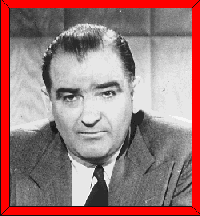 Senator Joseph McCarthy |
The Age of McCarthyism: A Brief History with Documents. Contents: Communism and National Security: The Menace Emerges, The Growth of the Anti-Communist Network, The State Steps In: Setting the Anti-Communist Agenda, Congressional Committees and Unfriendly Witnesses, Blacklists and Other Economic Sanction, Interpreting McCarthyism, and The Legacy of McCarthyism.
The Cold War and the "Hot Economy:" the 1950s. Contents: The Second Red Scare (May 26, 1938, the House Un-American Activities Committee (HUAC) was founded in order to investigate disloyalty among fascists and communists, but its focus soon became strictly anti-communist), The Trial of Alger Hiss, Truman loyalty program, and McCarthyism.
The Fight for America: Senator Joseph McCarthy. A biography of McCarthy: Contents: 1909-1950: Birth to Beltway, 1950-1954: A Man with a "Cause", and 1954-1957: The Bubble Bursts.
Hollywood Blacklist by Dan Georgakas in Buhle, Buhle, and Georgakas, ed., Encyclopedia of the American Left Urbana and Chicago: University of Illinois Press, 1992.
How did McCarthyism limit American political debate and freedom of speech in the 1950s? Site includes a video from CNN: McCarthyism during the Cold War. Lecture Outline: McCarthyism and Conformity in 1950s America, McCarthyism and Anti-communist Paranoia, and McCarthyism's affect on Americans' lives. Questions on McCarthyism. Web Links on McCarthyism.
HUAC, McCarthy, and the Reds. A brief timeline, from 1908 to 1957 (dates of birth and death of Senator Joseph McCarthy), on House Committee on Un-American Activities (HUAC), the role played by McCarthy against Communism.
Joseph McCarthy from Federal Bureau of Investigation (FBI). Joseph McCarthy - 4,296 pages. "Senator McCarthy, famous for conducting the McCarthy hearings regarding communism in the United States, was never the focus of an FBI investigation. FBI records contain extortion investigations and correspondence between McCarthy and J. Edgar Hoover."
Kazan and Miller. "Long, Bitter Debate From the '50's: Views of Kazan and His Critics" by Richard Bernstein, from New York Times, May 3, 1988.
Kazan, Miller, and the McCarthy Era from PBS, American Masters, for Teachers. Lesson 30. Procedures for Teachers. Organizers for Students include Questions about the McCarthy Era.
McCarthyism from PBS.
McCarthyism from Wikipedia, the free encyclopedia.
McCarthyism. On February 9, 1950, Senator Joseph McCarthy, a Republican from Wisconsin, claimed to have a list of 205 people in the State Department who were members of the American Communist Party. The possibility of communist subversion caused some people to lose their jobs when they admitted to have been Communist Party members. To save their own skins, accused Communist Party members had to expose other members of the Party during McCarthy's investigations. The ensued witch-hunt and anti-communist hysteria was known as McCarthyism.
Nightmare in Red: The McCarthy Era in Perspective. A brief summary of Richard Fried's book about the 1950's when Americans were experiencing the beginnings of fevered anti-communism that came to be known as McCarthyism.
The Politics of Scholarship: Liberals, Anti-Communism, and McCarthyism. An academic paper that analyzes the McCarthy phenomenon. See also The Legacy of McCarthyism for a different analysis of McCarthyism.
Red Scare: The Second Red Scare (1948-mid-1950s) from Wikipedia, the free encyclopedia.
The Testimony of Walter E. Disney Before the House Committee on Un-American Activities, 24 October, 1947. Full text documentary.
Victor Navasky's Naming Names. A general description of Hollywood blacklisting, from Chapter 10, Degradation Ceremonies in Victor Navasky's book Naming Names, published by New York: Viking Press, 1980.
The American Sense of Puritan. An in depth analysis of Puritanism and its historical roots. Includes a short analysis of the Salem Witchcraft as it related to Puritan beliefs.
The Puritan Way. Explains who the Puritans are and what are some of the common misconceptions about Puritans.
Puritanism: General Information. From A Christ Walk Church.
Puritanism in New England. A brief description of the Puritan movement in America.
The 1692 Salem Witch Trials: Documents and Participants. From the Salem Witchcraft Papers. Contents: Complete court documents (Verbatim Transcripts of the Legal Documents of the Salem Witchcraft Outbreak of 1692), Accusers, Defenders, Accused, "Afflicted Girls" (their names, place of residence, and location on map), Jurors, Puritan Ministers, and Judges.
17th c. Colonial New England with Special Emphasis on The Salem Witchcraft Trials of 1692. Includes numerous links to primary sources, e.g. texts of writings from the 17th century (court papers, first-person accounts of events, wills and deeds, image scans of actual documents, and more). Includes Arthur Miller's The Crucible: Fact & Fiction.
Accused of Witchcraft. Case history of individuals accused of witchcraft, some were from Salem, Massachusetts, others from as far away as England and Germany.
The Carey Document: On the Trail a Salem Death Warrant. See color photo of the actual Salem Death Warrant for Martha Carey, dated Salem, Massachusetts, June 10, 1692.
Colonial America 1600-1775 - K12 Resources. Topics covered Include General History of Colonial America, State and City Histories, Military History, Maps, Plantations and Other Historical Buildings, including Salem Massachusetts Georgian Architecture. View photos of Architecture in the 17th and 18th Centuries.
The Crucible - Witch Hunts. A teaching unit for Grades 9-11 designed by Carol White, David Underwood and Rusty Campbell. Unit begins with an overview of Puritain doctrine in relation to the Salem Witch Trials of the late 17th century. Lesson includes statistical analysis of the Salem Witch trials and simulation of the hysteria which infected the village like a virus. Students will demonstrate their appreciation of the effects of historical witch hunts.
Days of Judgment: The Salem Witch Trials of 1692. Series of lesson plans developed by teachers and the Peabody Essex Museum for students Grades 6-12. The entire Days of Judgment curriculum (52 pages) is available for download in PDF format.
Ergotism: The Satan Loosed in Salem? Convulsive ergotism may have been a physiological basis for the Salem witchcraft crisis in 1692, article by Linnda R. Caporael, from Science Vol. 192 (2 April 1976).
Famous American Trials: Salem Witchcraft Trials 1692. Contents: Chronology, Cotton Mather (Minister of the Old North Church in Boston), Biographies, Arrest Warrant, Examinations and Evidence, Petitions of Accused Witches, Death Warrant and List of Dead, Letters of Governor Phips, Petitions for Compensation, Images, The Crucible (by Arthur Miller, 1952), Bibliography & Links. Includes An account of the Salem witchcraft investigations, trials and aftermath by Professor Douglas Linder, University of Missouri-Kansas City (UMKC) School of Law.
Giles Cory and the Salem Witch Craft Trials from Cory Family Society. . "The ... epithet of witch-city which has tenaciously clung to Salem since 1692 is due to the fact that the witch trials and executions took place in that town. The source of the excitement which resulted in the death for alleged witchcraft of twenty persons within a year, lay in the a neighboring settlement, now the town of Danvers. At the time it was a parish of Salem Town, known as Salem Village. ... March 19th, a warrant was issued for the arrest of Martha Cory, wife of Giles Cory, and she was immediately taken into custody."
The Goody Parsons Witchcraft Case: A Journey to 17th Century Northampton.
Half-Hanged Mary - A remarkable, gut-wrenching poem posted by The Daily Poetry Movement, Portland Independent Media Center. "This poem is based upon a true story when men were practicing gendercide against women who dared to be independent or ask for equal rights. The poem is written by Margaret Atwood, who is, of course a professor ... Women were committing suicide by the thousands in Europe to escape terrible 'witch hunts.' But some strong women never die! ... "Half-hanged Mary" was Mary Webster, who was accused of witchcraft in the 1680's in a Puritan town in Massachusetts and hanged from a tree - where, according to one of the several surviving accounts, she was left all night. It is known that when she was cut down she was still alive, since she lived for another fourteen years." Excerpt: "8am - When they came to harvest my corpse ... cut my body from the rope, surprise, surprise: I was still alive. Tough luck, folks, I know the law: you can't execute me twice for the same thing. How nice. ... Before, I was not a witch. But now I am one."
Häxan (1922). Movie directed by Benjamin Christensen. A documentary film about the history of witchcraft, told in a variety of styles, from illustrated slideshow to dramatised events of alleged real-life events, right up to the early twentieth century.
Life and Times of Bridget Bishop. Biography of Bridget Bishop, the first woman to be put on trial in the historical Salem witch hunts. She was found guilty of being a witch and was hanged on June 10, 1692.
Maid of Salem (1937). Movie directed by Frank Lloyd. "It's an excellent retelling of the Salem Witch Trials and does a reasonably good job of explaining both how the hysteria began and the evil attitudes of those in charge that allowed for the hangings. Both Claudette Colbert and co-star Fred MacMurray do a great job with the excellent and intelligently written script. The movie would be a good film to explain the hysteria to kids but is entertaining enough that most should enjoy the film."
Mary Bradbury's Trial. On July 2, 1692, Mary Bradbury was charged with certain detestable acts called Witchcraft and Sorceries. Web page provides details of Mary Bradbury's trial.
Medieval Sourcebook: Witchcraft Documents [15th Century]. "Real or not, witches and witchcraft, were very real phenomena to the writers of the fifteenth century and later. Their writing tell us much about their thought worlds, and also their attitudes towards women. There can be no doubt that, whether or not there were real groups of witches, many women and a few men, suffered intense persecution and death as a result of intolerance. As Arthur Miller showed in his play The Crucible, set in Massachusetts at the time of the Salem witch trials but about McCarthyism, irrational prejudice and state action based on such, is hardly a medieval, or even a religious, phenomenon."
Milestone Historic Events. See original documents depicting milestone events in the U.S. as they actually appeared in the 1700s in newspapers, magazines, books and pamphlets.
National Geographic - Salem Witchcraft Hysteria. Interactive online game. Experience the Trial. Find out what happens if you confess to witchcraft. Find out what happens if you deny that you are a witch and claim that you are innocent. All events portrayed in this feature are based upon historical records.
People of the Salem Witch Trials from Wikipedia, the free encyclopedia. List of people include those who were accused: Found guilty and executed, Found guilty and pardoned, Found guilty and escaped, Refused to enter a plea and pressed to death, Found not guilty, Died in custody, Escaped, and names of Magistrates of the Court of Oyer and Terminer, 1692, Justices of the Superior Court of Judicature, 1693, Clergy, Public figures and politicians, Accusers, and The "Afflicted Girls".
Possible Causes of the Salem Witch Hunts. An anonymous author gives reasons for causes of the witch hunts: "Salem villagers were ... simply acting out their economic, political and social frustrations by blaming an intangible force."
Salem witch craft. In the 17th century, a belief in witches and witchcraft was almost universal. Written in the 1800s, this excerpt provides a glimpse into the history of Massachusetts.
Salem witch craft trial. In 1692, a mass hysteria occurred in the town of Salem, Massachusetts. 140 arrests, 19 hangings, one crushed by rocks, and several dying in jail while awaiting their trial. Everything that occurred was done in the name of ridding Salem of its supposed witches.
The Salem witch hunts. The Salem witch-hunt was the largest witch-hunt in colonial New England. 350 people were accused of witchcraft in New England; 185 of those were in Salem.
Salem Witch Museum: 1692 Sites Tour. Click on the town and city names on the map to view pictures (where available) and read about the sites in these locations. Locations include Salem, the scene of the witchcraft trials in 1692. View map of Salem to see the Site of the Courthouse in 1692, Site of Meetinghouse of First Church, Charter Street Cemetery, Superior Court Building, Broad Street Cemetery, Summit of Gallows Hill, etc.
Salem Witch Trial Conspiracy. The story of Sarah Wild, and the story of Rebecca Nurse, both hanged on July 19, 1692.
Salem Witch Trials. A Complete History in short paragraphs with links to related articles.
Salem witch trials. Comprehensive article from Wikipedia, the free encyclopedia. Background: Political, Local, Economic, Religious and Social context. Events include: Initial outbreak, Accusations and examinations before local magistrates, Formal prosecution: The Court of Oyer and Terminer, The Superior Court of Judicature, 1693, Legal procedures used. Spectral evidence, The witch cake, The touch test, Contemporary commentary on the trials. Aftermath and closure, Reversals of Attainder & Compensation to the Survivors and their Families, Memorials by Descendants, Salem witch trials in literature, the media, and popular culture, Medical theories about the reported afflictions.
The Salem Witch Trials. Contents: Salem Witchcraft, Trial Transcripts, Your Thoughts, The Accused, The Victims, Biographies, and FAQ with questions such as Were the victims of the Salem witch trials burned at the stake? What caused the Salem witch trials? What ended the trials? What is spectral evidence? Did witches really exist in Salem?
Salem Witch Trials. Documentary Archive and Transcription Project. Contents: 17th Century Documents & Transcriptions (Original Court Records, Record Books), Historical Maps (Map of Salem Village 1692, Map of Andover 1692, Map of Witchcraft Accusations February 29 - March 31, 1692, Province of Mass Bay 1692, Salem 1692), Archival Collections, Contemporary Books, and Project Mission.
The Salem Witch Trials. A short analytical essay on the Salem Witch Trial, with an animated image of burning flames.
Salem Witch Trials - The People. From About.com. Contents: Individuals involved in the Salem Witch Trials of 1692: accusers, accused, judges and others in Salem Village and the wider Puritan community. Includes biographies, testimony, petitions and other documents.
Salem Witch Museum - Salem Massachusetts. Salem 1692 Sites Tour, Salem Witch Trials of 1692.
The Salem Witch Trials by Dr. Donna Campbell, Department of English, Washington State University. "Who were the witches? Karlsen's demographic analysis of the available data shows that not those accused but those convicted of witchcraft in Salem and elsewhere were overwhelmingly women over the age of forty, with women over sixty being at an especially high risk for both accusation and conviction. The men convicted tended to be the family members of convicted female witches."
The Salem Witch Trials 1692: A Chronology of Events. Daily summaries of the witch trials from January 20 to November 25, 1692. Includes links to Witch Trials Memorials depicting the stones dedicated to the victims of the Salem Witch Trials.
Salem Witch Trials: The World behind the Hysteria. In 1692, 19 innocent men and women were hanged for witchcraft. DiscoverySchool.com provides information on: Life in 1692 Salem (Religion and Witchcraft, Economic and Social Divisions, and Puritan Children), The Story of the Witch Hunt (View a 6-minute multimedia movie narrated with sound and music), and The People behind the Trials (with primary sources, from letters to trial transcripts).
Salem Witch Trials as Fact and Symbol from Department of Anthropology, University of Waterloo, Canada. "A core belief held by New England Puritans, which may have led to both interpersonal suspicion and conceptions of a secret world, hidden from living humans, was the notion of predestination, the belief that God had already determined who was to be saved and who was to be damned." Includes a 6-minute video clip from Discovery Channel film recounting highlights of the Salem witch craze.
Salem Witchcraft in 1692: A Bibliography from Houston Library, Texas. List of sources with historical and other background information on the Salem Witchcraft Trials of 1692. Include electronic sources: Web sites and journal articles available from electronic databases and print sources: journal articles, books and chapters from books.
Salem Witchcraft. A history of brief history of Witchcraft. In 1692, in the town of Salem, Massachusetts, 24 people were killed after being tried as witches. Hundreds others were accused of being witches and wizards, but managed to escape the gallows. Why did this travesty of justice occur? View photos of Tombstones: Salem Witch Trials Memorial. Timeline: 1641-1957.
Salem Witchcraft, Volumes I and II by Charles Wentworth Upham. Online ebook from Project Gutenberg Literary Archive Foundation.
Secrets of the Dead II. Case 1. Background - The trouble in Salem began during the cold dark Massachusetts winter, January, 1692. Clues and Evidence - Possible cause of strange behavior might be Ergotism (ergot poisoning) which had indeed been implicated in other outbreaks of bizarre behavior. Interview with Linnda Caporael, Behavioral Psychologist, who believes ergot poisoning was possible in the 16th century. Site also provides an interactive exploration of Salem.
Three Sovereigns for Sarah (1985)(TV). Directed by Philip Leacock. "This is a great tool for teaching. I saw it in school, while we were learning about the Salem witches. Although some things needed explaining, the movie over all was awesome."
Tituba from Wikipedia, the free encyclopedia. "Tituba, also called Tituba Indian, was one of the first three people accused of practicing witchcraft during the Salem witch trials. ... She was ... the first person to confess to witchcraft in Salem Village. She at first denied that she had anything to do with witchcraft, but was then quickly coerced into confessing to having spoken with the Devil."
Today in History: March 1. On March 1, 1692, Salem, Massachusetts authorities charged Sarah Goode, Sarah Osborne, and a slave woman, Tituba, with practicing witchcraft.
What About Witches. The Salem Witch Trials of 1692 - A Brief Introduction, Photo of the Witch House in Salem, Massachusetts, Photo of the Salem Witch Trials Tercentenary memorial dedicated in 1992. Site also explains the word "Witch" for in order to understand the Salem witch trials, it is necessary to know the 17th-century definition of witchcraft.
Witch City. A non-fiction film by: Joe Cultrera, Henry Ferrini, Phil Lamy, Bob Quinn, John Stanton & May Liao. "Witch City is an uncompromising documentary about Salem, Massachusetts, a town that put the phrase 'witch hunt' into the American vocabulary and a place where today a Disneyesque version of history serves the purposes of both commercial and religious interests. Filmmaker Joe Cultrera returns home to find a place where the historical facts are sensationalized for the benefit of T-shirt hawkers and wax museum owners. New Age Wiccans (witches) make the pilgrimage to Salem, and evangelical Christians use street theater to wage a fire and brimstone war against them. Witch City is a cautionary tale about the consequences of manipulating historical facts for present-day gains."
Witchcraft in Salem Village: Intersections of Religion and Society. In 1691, the witch hunt episode began to unfold in a small rural neighborhood on the outskirts of Salem town, then the second-largest seaport in Massachusetts Bay Colony. Includes Historians Debate on the episode.
Witchcraft Archives. Links to Holdings of various archives from University of Virginia Special Collections Department.
Witchcraft Collection from Cornell University Library.
Witchcraft Links. Include Salem.
Witchcraft, Religious Fanaticism and Schizophrenia - Salem Revisited. Author points out that Puritan religious fanaticism was evident in Massachusetts a few years before 1692 and explains the role of Puritanism in the cause and actions of the witch hunt in 1692.
Witchcraft's Role in The Crucible written by Kenny Wells, student, Honors English 9, 1998.
Witches and Witchcraft in New England from About.com - Women's History. "Historical witches in Salem Village and elsewhere in New England and early America: witchhunts and witch trials. Often called the 'witch craze,' during these periods people -- often women -- were identified as witches, often with little evidence."
Women and Explanations for European Witchcraft Beliefs in the 16th and 17th Century by Act of Oblivion, 2003, Revised, article posted on All Empires History Forum.